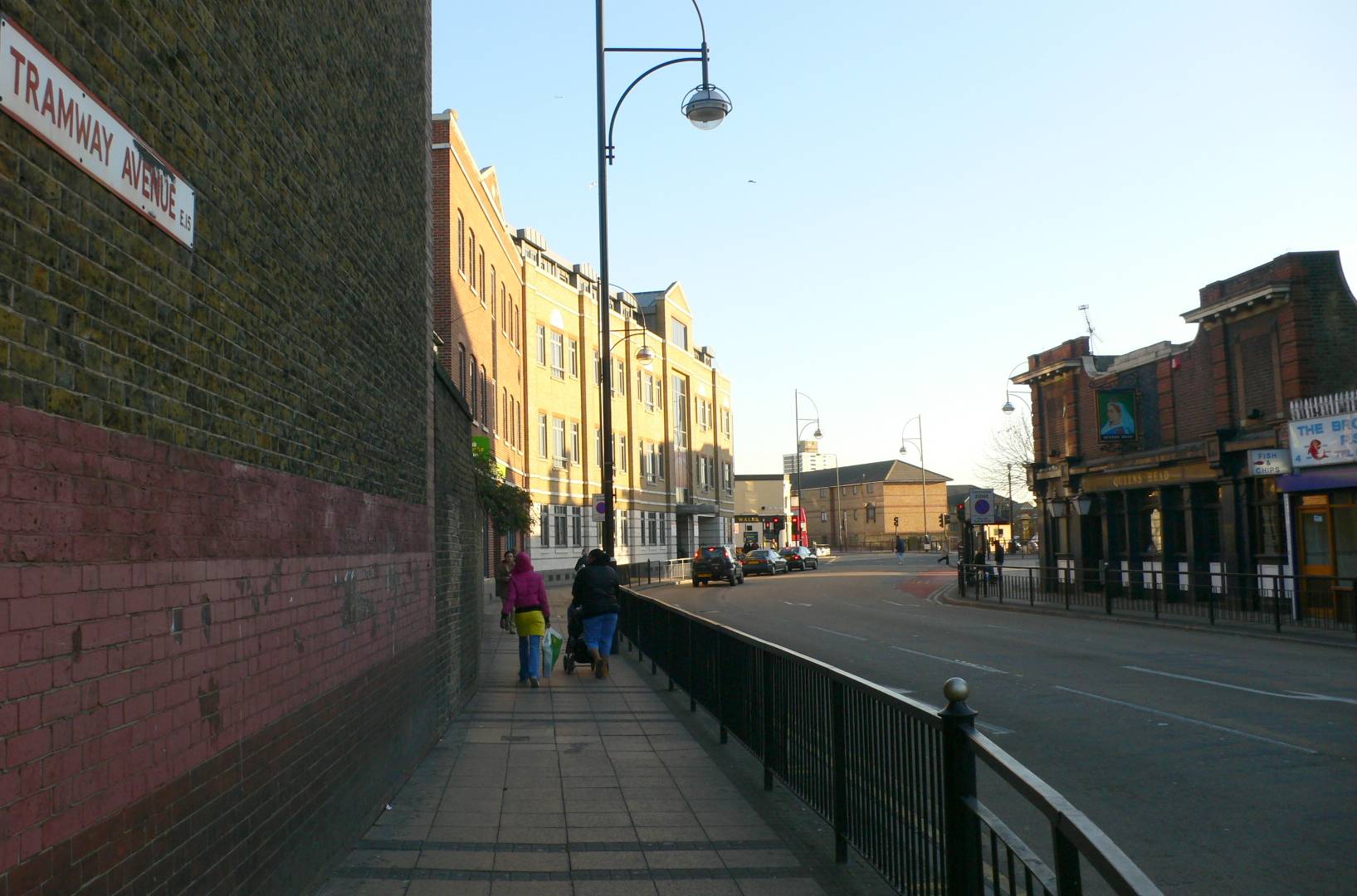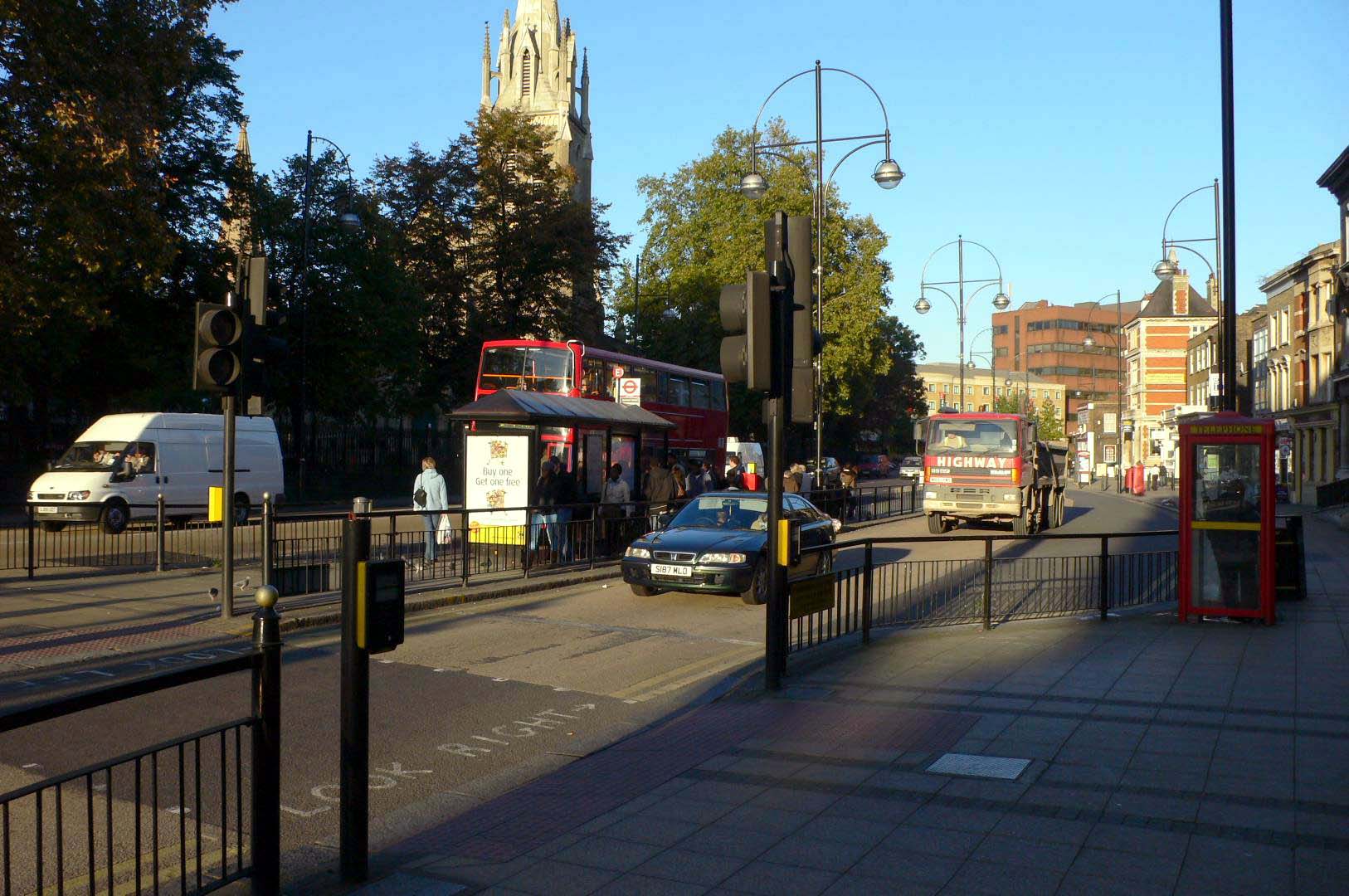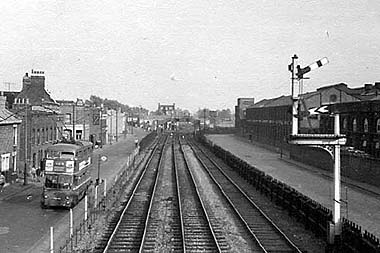
London Trolleybus in Tramway Avenue off Stratford Broadway
 |
| Click on picture [427] for an enlarged version |
From: "Tom Burns" <Topshednj2@aol.com>
Picture 427 was taken in Tramway Avenue, Stratford. I can't ever remember travelling on a trolleybus,
but certainly remember the bright shiny new RM's that replaced them. In later years the school I went to was directly to
the rear of West Ham Bus Garage and so was familiar with it's daily comings and goings. I understand that there were still
tram tracks in the garage during the 1960's.
Your most wonderful site bought many memories back into sharp focus for me. My family moved to Plaistow,
E.13 in 1960 and the trolleybuses ran outside our door. I don't know the route but they were replaced by RMs on the 238
I believe. I remember as a 6-8 year old being so upset-everything I enjoyed-steam trains, trolleybuses etc., was
being replaced and it seemed that they were being replaced first were I lived! I now know that wasn't the case with regard
to the trolleys, but I didn't know it then. I can remember the early hours of one Sunday morning when the overhead wires
where dismantled. It must have been fun for Mum and Dad since the LT crew were eye level with their bedroom!
I now live in New Jersey. The world I knew in the late 50s/early 60s seems so far away, so sites like yours are so
interesting.
 |
| Click on picture [275a] for an enlarged version |
 |
| Click on picture [277a] for an enlarged version |
From: "Phil Simpson" <phil.simpson@btinternet.com>
Looking through your wonderful site on many occasions I've come across this picture a number of times and, living not far away,
always thought I must go and have a look at that location and take a present day picture to see what has changed. Well I finally did it and the
picture is attached.
The Cinema on the left is no longer there, it was pulled down some 15 years ago and replaced with offices, one of which is the local Job Centre.
The building in the distance hidden behind the Trolleybus was Queen Mary's Hospital, again pulled down about 20 years ago and replaced by houses
and flats. I remember going to the Casualty there with a broken arm when I was 9 [in 1959] when the trolleybuses were still running.
The open space just seen directly to the right of the trolleybus is still the same and is what was West Ham Town Hall car park, the building is
now called the Old Town Hall and is out of sight behind the buildings on the right. The building seen between the bus stop and the front edge of
the trolleybus is the Prices of Wales pub and is still there as shown in my picture. The large building on the right which the bubble car sits
outside is the Queens Head pub and as you can see from my picture hasn't changed much in 50 years, nor has the buildings next door.
The bus flow through Tramway Avenue has been reversed since the original picture, buses now only flow toward the camera thus the absence of the
two bus stops on the left. The flow away from the camera [south] is now carried by a buses only lane behind the buildings on the right.
Trolleybus route 669 was replaced by the 69 bus which still passes through here, the routing being exactly the same between Canning Town and
Stratford.
I thought I would include the street sign in my picture although it is not the original but the brick wall is obviously the same. The granite sets
are long gone. Directly behind the camera is Stratford Broadway [picture 277a] which has also been the subject of many Trolleybus photos.
From: "Chis Cook" <C.Cook@btinternet.com>
I have no idea of the location of picture 427, but James Dean in 'Rebel' at the Gaumont [left] AND a bubble car [right]; Isetta (?) - you could drive it on a motorcycle licence [unless that was folklore].
Comment by David Bradley
As for "you could drive it on a motorcycle licence (unless that was folklore)". Almost true providing you were unable to select reverse. A welded blanking plate to stop this gear being selected was required if the car was built with reverse, not all were.
From: "Roly Wilcox" <RolyWilcox@aol.com>
Tramway Avenue off Stratford Broadway. The 669 had just completed a 90 degree
left hand turn. I can still remember the scrubbing sound of the back 2 axles as they slid on the cobbles from the Broadway.
West Ham Town Hall was to the right of the photographer. Terminating trolleybuses from the east would turn right beyond
the parked vehicles, having used the crossover shown above the trolleybus, around by the Town Hall and then face the
Broadway again. They would cross the westbound carriageway of the main road and enter the central refuge before entering
the eastbound carriageway.
A large church lies between the eastbound and westbound carriageway and effectively the church was in the centre of a
large one way system. There are numerous photographs of trolleybuses parked against a central paved strip area on the
westbound side. In tram days these roads were two-way.
 |
| Picture from the Transport of Delight web site |
In the late 50's my favourite journey was a 669 from Stratford Broadway to North Woolwich, a journey which took you over
the railway bridge at Plaistow Station, right into Upper Road, notable because of the vertical webbing erected there to
protect a nearby store from swinging and out of control dewired trolley poles. These appeared at a number of sites in the
trolleybus areas. Soon the bus would turn into Barking Road and head straight for London before turning left towards
North Woolwich, the remainder being through mainly dockland and industrial landscapes with typical dockland houses and
pubs.
On the right you would have glimpsed the run down station at Canning Town.
Like all the stations on the North Woolwich line
they were run down. However at peak times steam hauled trains full of dockers ran at 4 minutes intervals, reverting to
every 60 minutes outside peak hours. The real "piece de resistance" however was a long section
where the road paralleled the railway track, with trolleybus overhead being supported on bow supports having the poles
on only one side of the road. There was only a wire fence and virtually no footpath between the trolleybuses and the
trains.
This area of London deserves a book in its own right. There were so many branches off the railway into private sidings on
the opposite side of the track to the roadway that it was difficult to keep count of them and many ran over level crossings
across service roads. The Tate & Lyle factory dominated Silvertown.